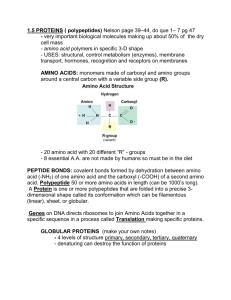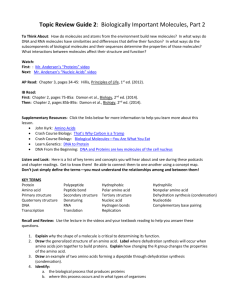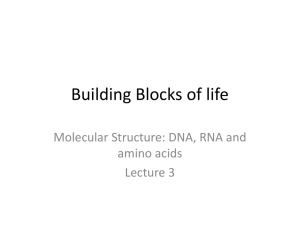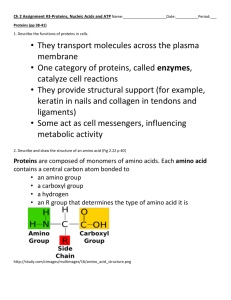MolBioIntro
advertisement
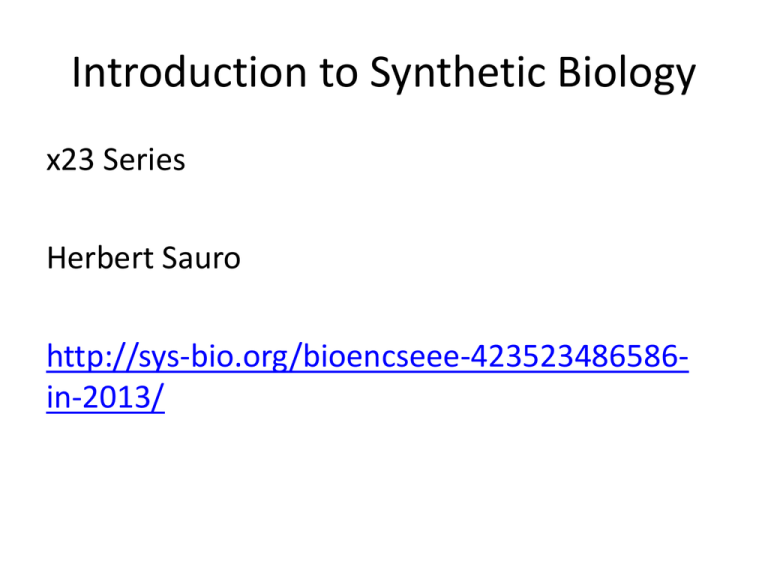
Introduction to Synthetic Biology x23 Series Herbert Sauro http://sys-bio.org/bioencseee-423523486586in-2013/ Syllabus Week 1/2: Essential Molecular Biology and Introduction a) What is life? b) Evolutionary time scale c) DNA, RNA and proteins d) The cellular context e) Engineering DNA f) What is Synthetic Biology? g) Applications and ethical issues Week 3: Modeling Synthetic Circuits a) The need for modeling in synthetic biology b) Stochastic and deterministic models c) Models of gene regulatory networks d) Software and modeling techniques e) Example simulations Syllabus Week 4/5: Synthetic Biology Circuits a) Basic circuit, repression and activation b) Feed-forward circuits c) Switches d) Oscillators e) Logic gates Week 6/7: Assembling a System: case study to build a working system a) Design objective b) The components c) The simulation d) DNA assembly methods e) Testing Syllabus Week 8: Components and Standardization a) Standards in Engineering b) The need for standards in synthetic biology c) Examples of existing standards, biobricks, SBOL, Registry, GenBank, etc d) Variety of components used in synthetic biology Week 9: Practical Issues in Creating Devices a) Computer aided design and workflows b) Orthogonality, Robustness, Tunability, Compatibility, Fan-Out, Signal Impedance c) Noise in biological systems Week 10: What is Life? Traditional View (Wikipedia): • • • • • • • The ability to move; plants turn toward light, sponges' collar cells' flagella turn round, fungi (exc. the little pot fungi, which have flagellate spores) and bacteria without locomotory apparatuses... huh. The ability to respire, turning nutrients into energy. For life on Earth, this process is glycolysis, and the storage of energy is maintained by ATP. Sensitivity to the outside world, and an ability to react. Lions maul you if you poke them with a stick, plants will grow their roots out, E. coli bacteria will change direction toward sugar and away from acid. Growth is self-explanatory; seeds or spores turn into plants or fungi or whatever, cute babies turn into annoying teenagers, bacteria... huh. Reproduction is also self-explanatory; amoebae undergo mitosis, plants release pollen to fertilise other plants, bacteria divide, mules and sterile humans... huh. Respiration generates waste, which is excreted or otherwise removed from the organism. Diffusion is a legitimate way to do this. To meet the above characteristics, the organism needs nutrition. Even plants are going to need water and minerals. What is Life? Modern View: • “self-sustaining chemical system capable of Darwinian evolution.” : Carl Sagan, Bruce Jokosky • “self-sustaining system capable of Darwinian evolution.” Minimal Life Form Timeline 4.54 3.8 3.5 2.4 1.8 0.6 Billions of Years Humans First Life Multicellular Organisms Oxygen in Atmosphere Blue-green Algae Formation of Earth Eukaryotic Cells Timeline } Typical Bacterium Typical Animal Cell Typical Plant Cell Eulena: Protist Amoeba: Protist Paramecium: Protist Characteristics of Earth Life • Liquid/Gel state • Chemistry • Massively Parallel Molecules Small molecules Source of energy or material, structural components, signal transmission, building blocks of macromolecules Water, sugars, fatty acids, amino acids, nucleotides Proteins Main building blocks and functional molecules of the cell Structure, catalysis of chemical reactions, signal transduction, communication with extracellular environment Molcules • DNA – Storage and reproduction of information • RNA – Intermediary molecule between DNA and protein Central Dogma Sequence of nucleotides Backbone is composed of sugars, linked to each other via phosphate bonds Each sugar is linked to a base Adenine (A), Thymine(T), Guanine (G), Cytosine (C) The Double Helix DNA is generally found in a double strand form A and T, C and G form hydrogen bonds Two strands with complementary sequences run in opposite directions 5’ A-T-C-T-G-A 3’ 3’ T-A-G-A-C-T 5’ They are coiled around one another to form double helix structure Genomes Organism Viruses Prokaryotes Eukaryotes MS2 Lambda Smallpox M. genitalium E. coli S. Cerevisiae (yeast) Arabidopsis Human Maize Lily Genome Size (KB) No. of Genes 4 50 267 580 4,700 12,068 100,000 3,000,000 4,500,000 30,000,000 ~30 ~ 200 470 4,000 5,885 20 -30,000 ~ 100,000 ~ 30,000 RNA – RNA is made of ribonucleic acids instead of deoxyribonucleic acids (as in DNA) • RNA is single-stranded • In RNA sequences, Thymine (T) is replaced by Uracil (U) – mRNA carries the message from genome to proteins – tRNA acts in translation of biological macromolecules from the language of nucleic acids to amino acids Proteins – Proteins are chains of amino acids connected by peptide bonds • Often called a polypeptide sequence • There are 20 different types of amino acid molecules (each amino acid in the chain is commonly referred to as a residue) – Proteins carry out most of the tasks essential for life • Structural proteins: Basic building blocks • Enzymes: Catalyze chemical reactions that enable the mechanism transform forms of matter and energy to one another (metabolism) • Transcription factors: Genetic regulation, i.e., control of which protein will be synthesized to what extent Amino Acids 20 Amino Acids Protein Structure Protein Stucture Size Variation http://www.rcsb.org/pdb/education_discussion/molecule_of_the_month/poster_quickref.pdf




